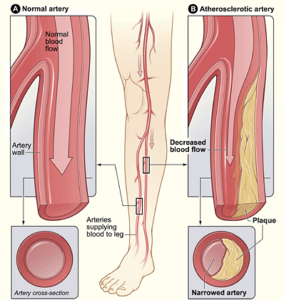
Spinal stenosis and PVD (peripheral vascular disease) both cause “leg pain.”
Is there a way to tell the difference between these two conditions?
“The pain from PVD, referred to as intermittent claudication, is very different from pain from spinal stenosis,” says Seyed-Mojtaba Gashti, MD, a board certified vascular surgeon with Broward Health Medical Center in Florida.
“Peripheral vascular disease typically causes achy, crampy pain in a certain muscle group supplied by a certain artery, most commonly calf muscles, after walking a certain distance,” says Dr. Gashti.
“The hallmark of pain caused by PVD is that it is very reproducible; since the arterial occlusion is a constant, meaning the blockage is there every day, patients complain of experiencing calf pain EVERY TIME they walk from point A to point B.

PVD. National Heart Lung and Blood Institute/Wikimedia Commons
“Pain that presents different than this should raise other possibilities.
“Spinal stenosis causes compression of the nerve roots/spinal cord and typically presents with a burning, or pins and needles kind of pain that may have no relation to walking at all.
“It can occur at rest, while sitting, flat in bed, or walking. It is typically very variable in presentation.”
Spinal stenosis can be confirmed with an MRI.

Dr. Gashti specializes in the diagnosis and treatment of vascular disease including abdominal and aortic aneurysm.
 Lorra Garrick has been covering medical, fitness and cybersecurity topics for many years, having written thousands of articles for print magazines and websites, including as a ghostwriter. She’s also a former ACE-certified personal trainer.
Lorra Garrick has been covering medical, fitness and cybersecurity topics for many years, having written thousands of articles for print magazines and websites, including as a ghostwriter. She’s also a former ACE-certified personal trainer.
.











